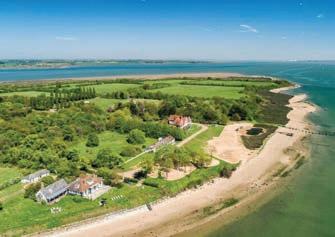
14 minute read
SIGHTS, CAMERA, ACTION
We have waited a long time to set off on new travel adventures and
if last year’s lockdowns left you staring wistfully at old photo
Advertisement
albums or empty Instagram feeds then it’s time for action. There’s nothing like a beautiful picture of a stunning destination to wake up the desire for travel and you don’t need to leave the country to find stunning locations to snap. Whether you’re looking to up your social game or add to your impressive photo collection, Great Britain has plenty of picturesque spots to capture.
With his trusty Canon 5DS camera and smartphone at the ready, we packed John Stammers off to travel the length and breadth of Britain and seek out the most photo-worthy places across the country.
Derwentwater located beside Keswick, Lake District
ST ANDREWS, SCOTLAND
Home to the University of St Andrews, the third oldest university in the English-speaking world and boasting a famous list of alumni — including Prince William and Catherine, Duchess of Cambridge. But St Andrews is more than just a historic university town, it’s also a magnificent place to take your camera. Even the town centre with its cobbled streets, beautiful fountains and local landmarks like the West Port is worth capturing. But there are a few idyllic locations you must add to your picture collection.
Whilst mostly in ruins, the medieval St Andrews Castle that oversees the coastline still invites a lot of fascination and awe, especially when you check out the stunning views towards the sea. Despite the castle’s small size, the photo opportunities are monumental (if you’ll pardon the pun).
Similarly, the St Andrews Cathedral is another collection of ruins that make for striking photographs. Once upon a time, it was Scotland’s largest building. The tall square tower, part of the old church before it was a cathedral, was built to hold the relics of St Andrew himself. It’s a popular spot for photography, and you’ll have to snap it for yourself to see why. Also recommended is a visit to the windswept West Sands beach. No matter the time of day, you’ll find a wealth of fantastic opportunities for a pretty picture. But you’ll really want to be there for sunset or sunrise — that’s where the most magical shots are captured. There’s also Kingsbarns in the East Neuk of Fife, situated around 6.5 miles outside of St Andrews. As well as a hot golfing spot, Kingsbarns is a great location to stroll through the golden sandy shores with your camera close to hand.
Other photo-worthy destinations in Scotland
• Luskentyre and Scarista, Isle of Harris, Outer Hebrides • Buachaille Etive Mòr, Glen Etive, Highlands • Kilchurn Castle, Argyll and Bute • Isle of Skye, Inner Hebrides • Rannoch Moor, Loch Rannoch, Perth and Kinross • Black Rock Cottage, Glen Coe, Highlands • Edinburgh Castle, Castlehill, Edinburgh • Fingal’s Cave, Isle of Staffa, Inner Hebrides
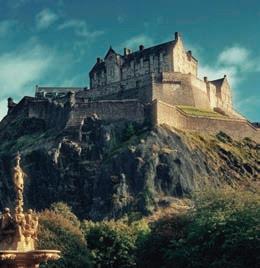

LAKE DISTRICT, NORTH WEST ENGLAND
The Lake District is the most popular and largest national park in England, covering more than 1,400 square miles. Sometimes referred to as Lakeland, it’s home to some of the most scenic landscapes in Britain. Aside from its gorgeous lakes, there are also some awe-inspiring mountains and dazzling forests. With such breath-taking scenery and extraordinary light quality, the Lake District might just be the most photogenic region in the UK. Wherever you stop, you’re bound to find something beautiful to capture. However, there are a few snappable spots we must highlight.
Located beside Keswick is an enchanting lake called Derwentwater. On the water are numerous little islands that add character to any photo you take. But whether you walk along the Derwent Piers or hop on a boat, the picture potentials are vast. Early mornings usually offer the best atmospheric conditions, but you’ll collect an array of interesting shots if you make a day of it.
The Windermere lake is another stunning location to expand your photo album. At 10.5 miles long, one mile wide and 220 feet deep, it is the largest natural lake in England. The South Lakes valleys around Windermere are equally photographable and consist of narrow winding lanes, which are bounded with hedgerows and dry-stone walls. They’re also surrounded by wondrous woodlands. Whilst autumn is generally considered the most ideal time of year to capture the most wonderful natural colours in the forests, winter offers its own charming photo opportunities.
Another lake you don’t want to miss out on snapping is Ullswater, which is surrounded by the most amazing mountain scenery with some gentler but equally picturesque hills further north. At 7.5 miles long, it’s the second largest lake in England and the third deepest at 250 feet. But it’s not just the lake itself that demands your camera, it’s the surrounding landmarks, too. This includes the villages Glenridding and Pooley Bridge, the fells above Martindale and the Kirkstone Pass.
Other photo-worthy destinations in North West England
• Albert Dock, Liverpool • Winter Hill, Lancashire • Scafell Pike, Cumbria • River Dee, Chester • Crosby Beach, Crosby, Merseyside


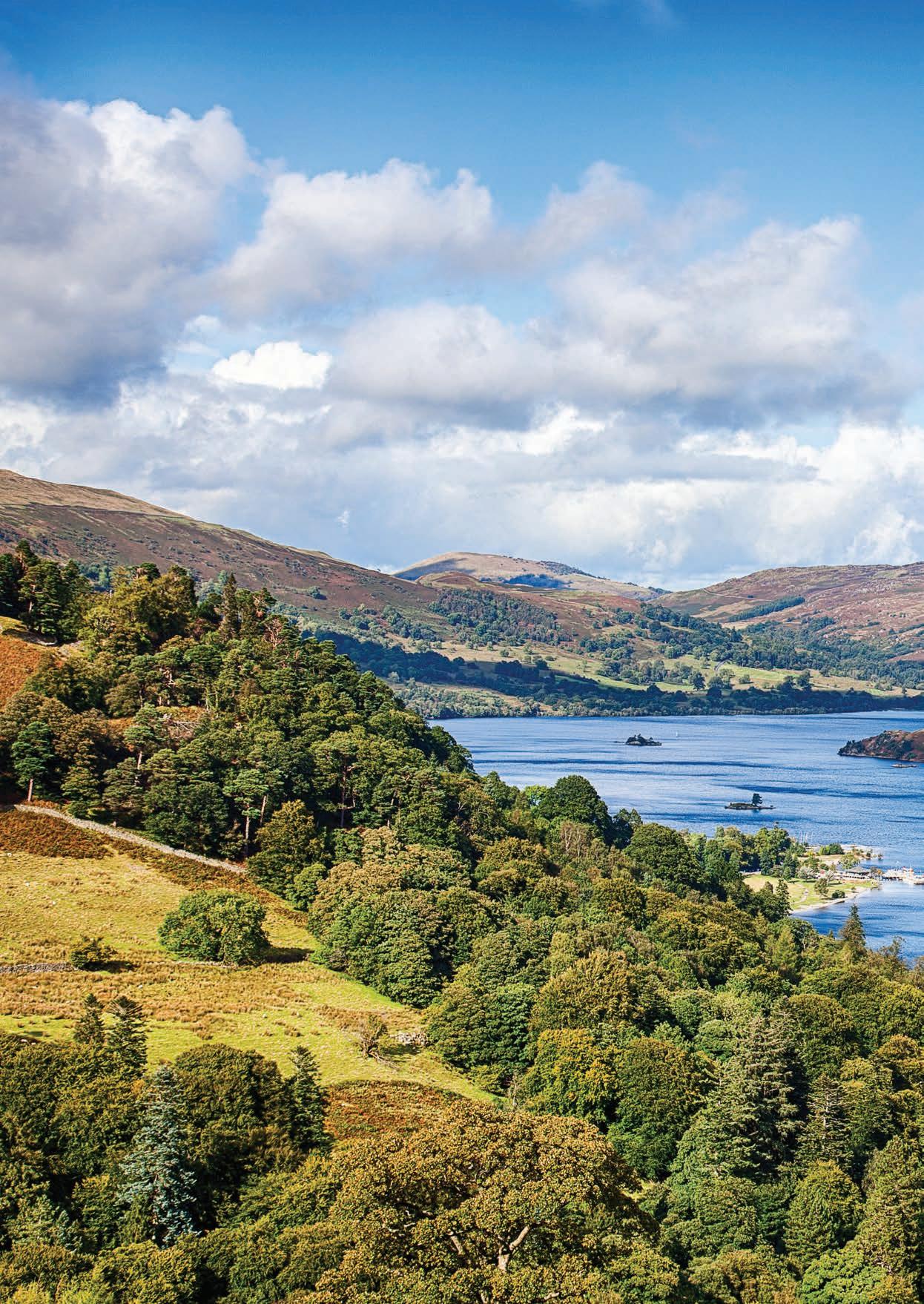
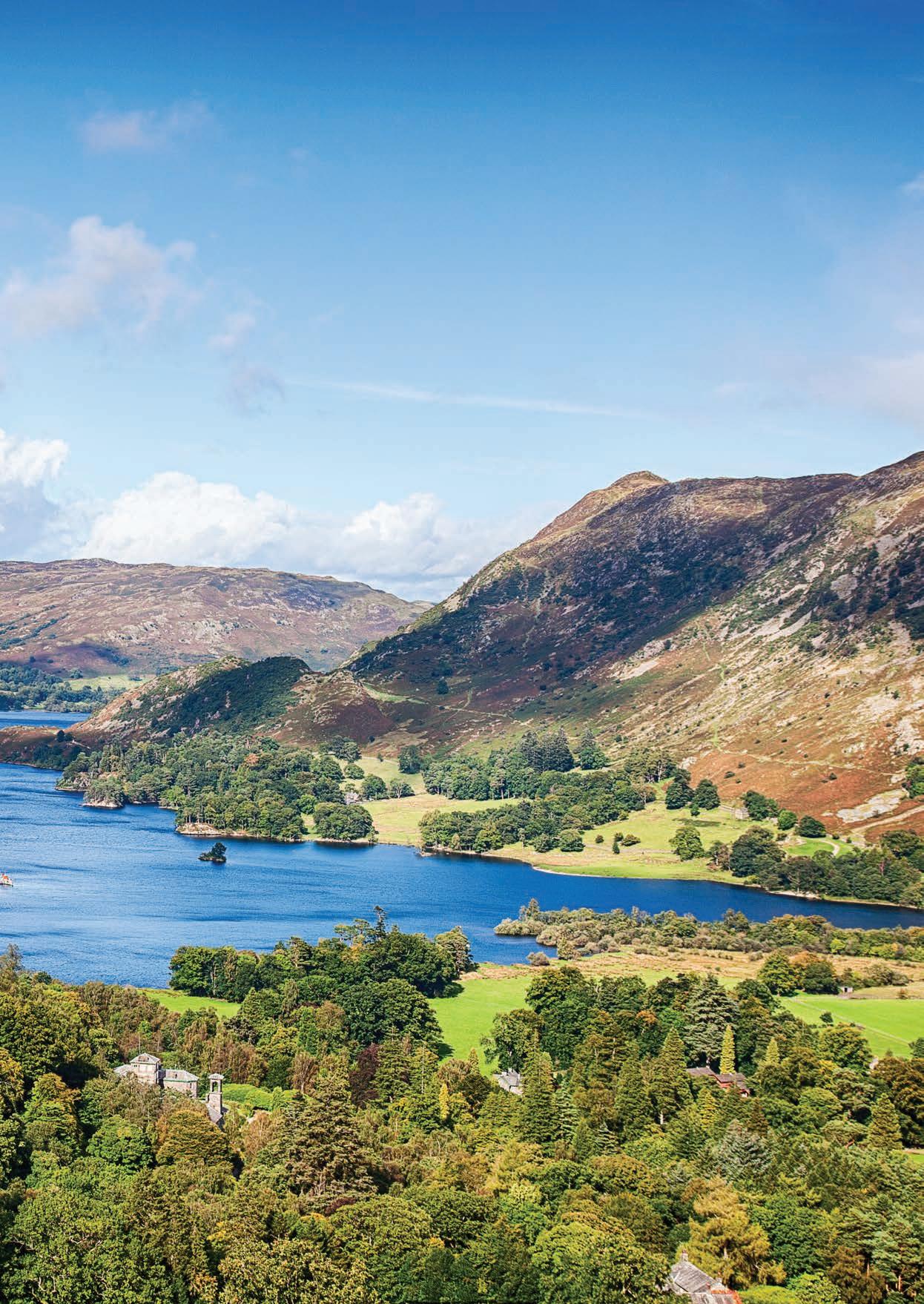
YORKSHIRE DALES, NORTH EAST ENGLAND
Covering 841 square miles, the Yorkshire Dales National Park has limitless potential for capturing unique photographs. From windswept landscapes and fantastic waterfalls to tranquil valleys and fascinating coves. The array of moods and colours are perfect no matter what level of photographer you are or what time of year you visit. Wherever you find yourself in the Dales, you’ll find an irresistible picture. There are, however, some top spots you must check out.
All the Dales’ waterfalls are undoubtedly beautiful, but a couple of particular note are the West Burton Falls and Janet’s Foss. The former is quite a nice shady spot often called the Cauldron Falls due to its striking plunge pool. To convince you of its allure, the artist J.M.W. Turner picked this spot for one of his paintings. Furthermore, the white-breasted bobbing dipper and different varieties of wagtails love to dart into the water to catch insects. Perhaps this is your chance for a cool action shot. Whilst the latter, Janet’s Foss, is said to be named after the queen of the fairies who supposedly lived in a little cave behind this enchanting waterfall. The surrounding woodland is equally idyllic with its spring carpets of bluebells and wood garlic.
One of the national park’s crowning landmarks is the Gordale Scar and once you’ve captured it on film you’ll never forget why. This incredible hidden gorge has impressed visitors for hundreds of years and inspired many works from famous artists and writers. This impressive natural feature was formed thanks to successive Ice Ages carving it deeper and deeper over thousands of years into the awe-inspiring gorge we see today. The water that flows over the waterfalls at the heart of the ravine is rich in dissolved limestone and has resulted in mossy rocks creating a soft tufa screen that is a gorgeous feature at Gordale. Both the Scar and Janet’s Foss also make up part of the “Malham Landscape Trail” that is full of photo-worthy hotspots.
Several high roads and passes offer jaw-dropping views of the surrounding valleys and fells, but you’ll get the most enviable shots from Buttertubs Pass. This road crosses the high moorland between Wensleydale and Swaledale, the latter of which is a must-visit for stunning pics. At the heart of Swaledale is the River Swale, which flows through traditional hay meadows, which dazzle with wildflowers in the summer but is still charming in the colder seasons. The exquisite pattern of field walls, barns and meadows is so special to Swaledale that highly snap-worthy spots like Muker Meadows have been given special protection.
Other photo-worthy destinations in North East England • North York Moors National Park • Northumberland National Park • Bamburgh Castle, Bamburgh • Lindisfarne Castle, Holy Island • Scarborough Castle, Scarborough • Farne Islands, Northumberland


SNOWDONIA, WALES
You’ll have heard of Mount Snowdon, the highest mountain in the UK outside of the Scottish Highlands. Standing at 3,560 feet tall, the vast range of potential shots of the gorgeous landscapes makes this one of the most enviable photography spots in Britain. What you might not know is the numerous other snappable spots the Snowdonia National Park has to offer. There are nine mountain ranges, fifteen peaks above 3,000 feet and twenty-three miles of sweeping coastline. Snowdonia is a beautiful backdrop to a rich history and heritage that encompasses stone monuments and medieval castles. It’s also home to an incredible diversity of fauna and flora, including the rare Lili’r Wyddfa—more commonly known as the Snowdon Lily—found only at the highest peaks. Wherever you go, you’ll find plenty of places to stop for a picture. However, there are a few specific locations that will elevate your photography.
The hills that surround the Mawddach Estuary have awed visitors for years and years. The views here are utterly bewitching, from the wooded hillsides to where the River Mawddach meets the sea. It’s a superb location to get plenty of photographs to wow your friends and family.
Then there’s the mountain Cadair Idris situated at the southern end of the national park, which overlooks possibly the most photographed lakes in all of Snowdonia. Translating to “chair or Idris” it is said that Idris the Giant of Welsh mythology used the mountain peaks as a place of rest to stargaze. It’s certainly an ideal spot for it. Also, nearby is the peaceful valley of Dysinni, which we recommend capturing from the striking Bird Rock.
We also couldn’t overlook the Rhinog Mountains, often quoted as Snowdonia’s best-kept secret. To find this landscape, you’ll need to descend the tallest peak. Only the most dedicated hikers willing to put in a full day’s journey will have this opportunity, hence why it looks unexplored. But this means you’ll likely find it free of crowds and the untamed Rhinogs promise the chance to snap pictures few will have ever captured. Plus, it also passes the navy-blue lake of Llyn Hywel and further in the distance you might see the Irish Sea if it’s a clear day. Whilst it’s not a route for the faint of heart, those who manage it will be rewarded with some of the best scenic views Snowdonia has to photograph.
Other photo-worthy destinations in Wales
• Carreg Cannen Castle, Brecon Beacons National
Park • Afon Mawddach, Gwynedd • Llanddwyn Island (Ynys Llanddwyn), Anglesey • Newborough Forest, Anglesey • Point of Ayr Lighthouse, Talacre, Flintshire • Conwy Castle, Conwy • Caernarfon Castle, Caernarfon, Gwynedd


DURDLE DOOR, SOUTH WEST ENGLAND
Situated on the Dorset Coast, Durdle Door is arguably one of the most famous photographable destinations in the UK. The astoundingly beautiful natural limestone arch on the Jurassic Coast and picturesque beach have attracted photographers and videographers alike. Several music videos have been filmed at Durdle Door, including “Shout” by Tears For Fears, “Loverboy” by Billy Ocean and “Saviour’s Day” by Cliff Richard. The surrounding landscapes have also served as the sets for scenes in a number of films, including Nanny McPhee and the 1967 production of Far From the Maddening Crowd. It truly is a photographer’s dream. We should mention that due to its fame it can be tricky to find a spot to get an original shot. Beloved the world over, it also invites huge crowds, so if you’re looking to get some snaps free of people then you might want to research some tips on what to do — especially if your plan is to edit them out later. However, just because it is overwhelmingly popular doesn’t mean you should miss out on the action. Durdle Door would still make a super addition to your photo album and there are plenty of points from the cliffsides to the beach that are worth seeing through a lens.
Furthermore, Durdle Door is not the only landmark in the area worthy of shooting. Less appreciated are the formidable chalk hills of Bat Head and the enchanting Man O’War Bay. Butter Rock also has its own allure and has been largely ignored by many photographers, their attention instead fixated on the arch.
Also not to be missed, along the Jurassic Coast and within walking distance of Durdle Door, is the Lulworth Cove — one of the world’s finest coves — and Stair Hole beside it. There’s also an impressive line of rocks that offer a photo-worthy view over Pondfield Cove called Gad Cliff. Around the cliff and the cove, you’ll discover various World War Two anti-tank structures that have since become known as “dragon’s teeth”. So don’t let Durdle Door’s popularity dissuade you from seeking out some original shots.
• Dartmoor National Park, Devon • Exmoor National Park, Somerset • New Forest National Park, Hampshire • South Downs National Park (from Hampshire to East
Sussex) • Wistman’s Wood, Dartmoor, Devon • Isles of Scilly, Cornwall • St. Michael’s Mount, Mount’s Bay, Cornwall • Stonehenge, Wiltshire
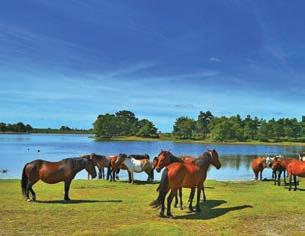



HYDE PARK, SOUTH EAST ENGLAND
Hyde Park is arguably the most popular of central London’s green spaces. It spans 350 acres and contains around 4,000 trees, which is quite astounding when you consider that it’s surrounded by London’s urban sprawl. The greenery and tree-lined avenues alone make this one of the most lens-worthy locations in London, but what you might not know is how many pictureperfect spots there really are.
Curving through the park’s vibrant gardens is the wondrous Serpentine Lake. The lake itself is beautiful, but don’t neglect the photo opportunities surrounding it. The gardens are filled with quaint bandstands, great trees and neat walkways. The continuous presence of sculpture and installation art around the Serpentine Gallery also demands your camera’s attention. Simon Gudgeon’s Lakeside Serenity sculpture and T.B. Huxley-Jones’ “Joy of Life” fountain are superb from any angle.
If you want even more natural beauty then the Rose Garden is a varicoloured feast for your lenses, featuring the most colourful beds of roses in London. It was designed from the concept of horns sounding upon arrival into the park from Hyde Park Corner. The circular centre enclosed by the yew hedge is intended to depict the mouth of a trumpet or horn, whilst the seasonal flower beds are the flaring notes coming out of the horn. Summer is widely considered the most ideal time for the most eye-catching shots, but there’ll always be something to shoot no matter the time of year. Be sure to capture the fountain statue of Diana the Huntress, sculpted by the very first female member of the Royal British Society of sculptors, Lady Feodora Gleichen, in 1899. We must also mention the breathtaking Italian Gardens. Whilst they are technically part of the neighbouring Kensington Gardens rather than Hyde Park, if you’re in Hyde Park then you might as well take a scenic stroll over there. There’s plenty of photo-worthy opportunities en route, and once you arrive you’ll be greeted by an elaborate mix of four main basins, featuring the Portland stone and white marble Tazza Fountain, central rosettes carved in Carrara marble and a collection of stone statues and urns. Also worth seeking out is the initials of Queen Victoria and Prince Albert etched into one of the Pump House’s walls. If somehow you’re not convinced that the garden’s allure is not worth capturing on film, it’s been the star location in several movies, such as Bridget Jones: The Edge of Reason.
Other photo-worthy destinations in South East England • Broads National Park, Norfolk • Southwold Pier, Southwold, Suffolk • Windsor Castle, Windsor, Berkshire • White Cliffs of Dover, Kent • Little Venice, London • Sky Garden, London • Osea Island, Maldon, Essex
